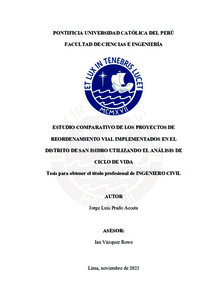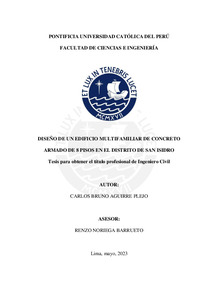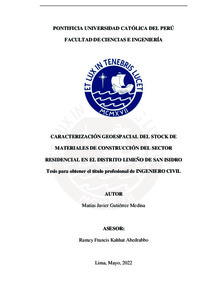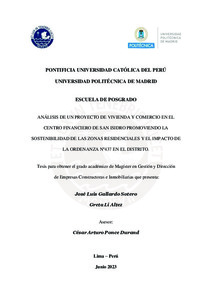| dc.contributor.advisor | Vázquez Rowe, Ian | |
| dc.contributor.author | Prado Acosta, Jorge Luis | |
| dc.date.accessioned | 2024-02-12T18:23:13Z | |
| dc.date.available | 2024-02-12T18:23:13Z | |
| dc.date.created | 2023 | |
| dc.date.issued | 2024-02-12 | |
| dc.identifier.uri | http://hdl.handle.net/20.500.12404/27082 | |
| dc.description.abstract | Cada vez es mayor la presencia de impactos ambientales negativos asociados a las actividades afines a la
infraestructura vial urbana. Esto ha generado un debate en relación a la forma en que se planifica el sistema
de transporte. Las instituciones, tanto públicas como privadas, reconocen que para establecer una
movilidad más sostenible es necesario formular soluciones más eficientes de gestión de tráfico. Si bien a
la fecha las principales acciones llevadas a cabo se centran en el rediseño vial y la humanización de los
espacios públicos, son pocos los estudios sobre estos temas que demuestran si en efecto los resultados
generados son positivos en todas sus dimensiones. En tal sentido, se decidió realizar un análisis de ciclo
de vida (ACV) a fin de determinar los impactos ambientales relacionados con las calles urbanas de la
ciudad de Lima. Para ello, fueron evaluadas las etapas de demolición, construcción, operación y
mantenimiento de tres proyectos emplazados en el distrito de San Isidro. Así, para cada escenario, se
obtuvo la información referente al consumo de materiales y se modelaron las emisiones al medio ambiente
con base en una unidad funcional de 250 metros lineales de infraestructura vial intervenida en 1 año de
operación. El método de evaluación del IPCC 2013 se utilizó para el cálculo del cambio climático y
ReCiPe 2016 para otras categorías de impacto ambiental. En cuanto a la huella de carbono, se determinó
un balance general en el rango de 16 y 37 toneladas de CO2 eq al año por cada viario como resultado de
los efectos directos de la construcción y el tráfico en la etapa de uso. En cambio, la formación de material
particulado y la acidificación terrestre se manifestaron en una escala pequeña con magnitudes para los
casos más críticos de 67 kg PM2.5 eq y 112 kg SO2 eq, respectivamente. Hecho que representa riesgos
mínimos para la salud humana o el entorno urbano local y que se le puede atribuir al buen comportamiento
de la materia prima y al nivel tecnológico de los equipos y maquinaria. Hasta la fecha, este estudio es uno
de los pocos de su tipo y los resultados obtenidos sirven como imagen de la carga ambiental que este tipo
de proyectos puede inducir en los ecosistemas. Se recomienda extender la evaluación a otros proyectos
viales ubicados en áreas de alta densidad urbana a fin de tener una visión más integral del panorama actual
del transporte en la ciudad. Asimismo, se considera que los resultados e inventarios obtenidos pueden
servir como una línea base para futuras investigaciones orientadas a la mejoría de la infraestructura vial en
zonas urbanas. | es_ES |
| dc.description.abstract | The presence of negative environmental impacts associated with activities related to urban road
infrastructure is increasing. This has generated a debate in relation to the way in which the transport system
is planned. Institutions, both public and private, recognize that in order to establish more sustainable
mobility it is necessary to formulate more efficient traffic management solutions. Although to date the
main actions carried out focus on road redesign and the humanization of public spaces, there are few
studies on these issues that show whether the results generated are indeed positive in all dimensions. In
this sense, it was decided to carry out a life cycle analysis (LCA) in order to determine the environmental
impacts related to the urban streets of the city of Lima. For this, the stages of demolition, construction and
operation and maintenance of three projects located in the district of San Isidro were evaluated. Thus, for
each scenario, the information regarding the consumption of materials was obtained and the emissions to
the environment were modeled based on a functional unit of 250 linear meters of road infrastructure
intervened in 1 year of operation. The IPCC 2013 assessment method was used for the calculation of
climate change and ReCiPe 2016 for other environmental impact categories. Regarding the carbon
footprint, a general balance was determined in the range of 16 and 37 tons of CO2 eq per year for each
road as a result of the direct effects of construction and traffic in the use stage. On the other hand, the
formation of particulate matter and terrestrial acidification manifested themselves on a small scale with
magnitudes for the most critical cases of 67 kg PM2.5 eq and 112 kg SO2 eq, respectively. A fact that
represents minimal risks to human health or the local urban environment and can be attributed to the good
performance of the raw material and the technological level of the equipment and machinery. To date, this
study is one of the few of its kind and the results obtained serve as an image of the environmental load that
this type of projects can induce on ecosystems. It is recommended to extend the evaluation to other road
projects located in areas of high urban density in order to have a more comprehensive vision of the current
panorama of transportation in the city. Likewise, it is considered that the results and inventories obtained
can serve as a baseline for future research aimed at improving road infrastructure in urban areas. | es_ES |
| dc.language.iso | spa | es_ES |
| dc.publisher | Pontificia Universidad Católica del Perú | es_ES |
| dc.rights | info:eu-repo/semantics/openAccess | es_ES |
| dc.rights.uri | http://creativecommons.org/licenses/by-sa/2.5/pe/ | * |
| dc.subject | Carreteras--Aspectos ambientales--Perú--San Isidro (Lima : Distrito) | es_ES |
| dc.subject | Análisis del impacto ambiental--Perú--San Isidro (Lima : Distrito) | es_ES |
| dc.subject | Análisis de ciclo de vida--Perú--San Isidro (Lima : Distrito) | es_ES |
| dc.subject | Tráfico urbano--Perú--San Isidro (Lima : Distrito) | es_ES |
| dc.title | Estudio comparativo de los proyectos de reordenamiento vial implementados en el distrito de San Isidro utilizando el análisis de ciclo de vida | es_ES |
| dc.type | info:eu-repo/semantics/bachelorThesis | es_ES |
| thesis.degree.name | Ingeniero Civil | es_ES |
| thesis.degree.level | Título Profesional | es_ES |
| thesis.degree.grantor | Pontificia Universidad Católica del Perú. Facultad de Ciencias e Ingeniería | es_ES |
| thesis.degree.discipline | Ingeniería Civil | es_ES |
| renati.advisor.cext | 001084152 | |
| renati.advisor.orcid | https://orcid.org/0000-0002-7469-2033 | es_ES |
| renati.author.dni | 72481113 | |
| renati.discipline | 732016 | es_ES |
| renati.juror | Cabrera Vega, Félix Israel | es_ES |
| renati.juror | Vázquez Rowe, Ian | es_ES |
| renati.juror | Sanchez Matos, Joan | es_ES |
| renati.level | https://purl.org/pe-repo/renati/level#tituloProfesional | es_ES |
| renati.type | https://purl.org/pe-repo/renati/type#tesis | es_ES |
| dc.publisher.country | PE | es_ES |
| dc.subject.ocde | https://purl.org/pe-repo/ocde/ford#2.01.01 | es_ES |










